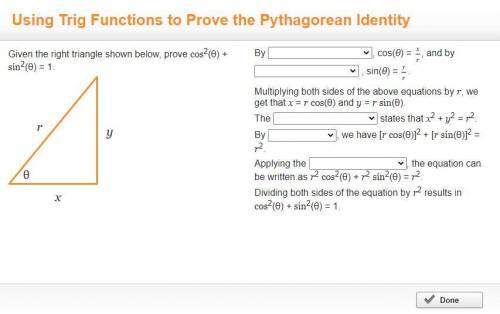
Mathematics, 11.10.2020 08:01, surfskate
Given the right triangle shown below, prove cos2(θ) + sin2(θ) = 1.
A triangle with sides x, y, and hypotenuse r. Angle theta is opposite to side y.
By
, cos(θ) = StartFraction x Over r EndFraction, and by
, sin(θ) = StartFraction y Over r EndFraction.
Multiplying both sides of the above equations by r, we get that x = r cos(θ) and y = r sin(θ).
The
states that x2 + y2 = r2.
By
, we have [r cos(θ)]2 + [r sin(θ)]2 = r2.
Applying the
, the equation can be written as r2 cos2(θ) + r2 sin2(θ) = r2.
Dividing both sides of the equation by r2 results in cos2(θ) + sin2(θ) = 1.


Answers: 3
Other questions on the subject: Mathematics

Mathematics, 21.06.2019 13:30, noseugh
Select all the correct answers. natalie buys a new car. in the first month, the odometer on the car records 800 miles. from past experience, she expects to drive 900 miles per monthselect all the functions that can be used to find the number of miles, f(n), recorded on the odometer after n months. of(n) = 800n + 100f(n) = 9001 - 100f(n) = 900n + 800(1) = 800; }(n) = f(n - 1) + 900, for n > 2f(1) = 800; 1(n) = f(n − 1) + 100, for n > 2(1) = 900; }(n) = f(n - 1) + 800, for n > 2
Answers: 2



Mathematics, 22.06.2019 00:00, lllamasarebae5995
I've been working on this for a few days and i just don't understand, it's due in a few hours. you. the direction of a vector is defined as the angle of the vector in relation to a horizontal line. as a standard, this angle is measured counterclockwise from the positive x-axis. the direction or angle of v in the diagram is α.part a: how can you use trigonometric ratios to calculate the direction α of a general vector v = < x, y> similar to the diagram? part bsuppose that vector v lies in quadrant ii, quadrant iii, or quadrant iv. how can you use trigonometric ratios to calculate the direction (i. e., angle) of the vector in each of these quadrants with respect to the positive x-axis? the angle between the vector and the positive x-axis will be greater than 90 degrees in each case. part cnow try a numerical problem. what is the direction of the vector w = < -1, 6 > ?
Answers: 1
Do you know the correct answer?
Given the right triangle shown below, prove cos2(θ) + sin2(θ) = 1.
A triangle with sides x, y, and...
Questions in other subjects:

English, 31.03.2020 16:22








Biology, 31.03.2020 16:22

Chemistry, 31.03.2020 16:22






